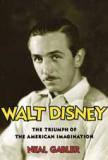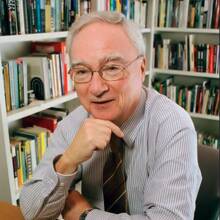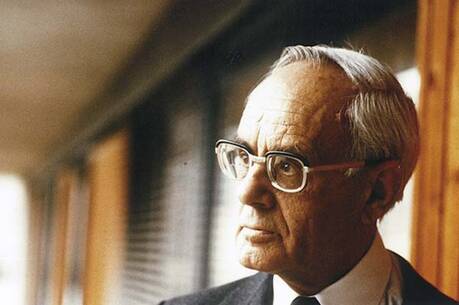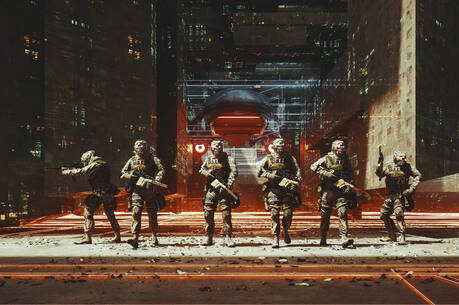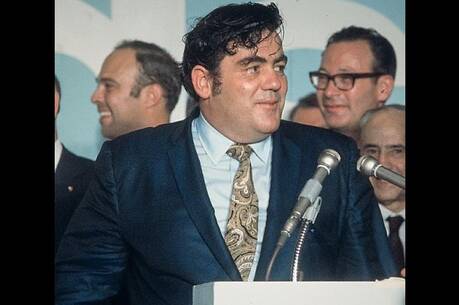Fantasies Abounding
Viktor Frankenstein created the Monster. Walt Disney created Walt Disney, but the outcome was pretty much the same. The creation takes control of the creator. Even more chilling in Neal Gabler’s unspoken subtext is the suggestion that the Disney empire provides a cautionary tale for America. Massive success includes, if not selling, at least mortgaging the soul. Thus the subtitle’s “Triumph” includes more than a dash of bitter irony.
Walter Elias Disney lived out the 19th-century American dream of the self-made man who overcame poverty. By spunk, imagination and hard work, he not only amassed a personal fortune but placed an unmistakable stamp on American culture. A parallel comes to mind. Thomas Edison led us into the American century with the light bulb and the phonograph; Disney guided America with a mouse and an amusement park. Other innovators, from Henry Ford to Bill Gates, developed products. Disney marketed fantasies.
Although Walt lived for a time in Chicago and Kansas City, he always returned in memory to Marceline, Mo., a rural community that he seemed to idealize more as the reality drifted further away in time. Because of his demanding parents and impoverished circumstances, young Walter sought friendship with farm animals. In Walt Disney Neal Gabler, a senior fellow at the Norman Lear Center for the Study of Entertainment and Society at the University of Southern California, traces the roots of Disney’s signature preoccupations with small-town life and anthropomorphized animals back to his years in Marceline.
Dropping out of high school after one year, Disney devoted himself to drawing. Too young for the army, he became an ambulance driver in France during the closing days of World War I. He hoped one day to be a cartoonist for the Kansas City newspapers and set up an independent studio. Despite the literal threat of starvation, Disney could not abide the thought of working for anyone else. Movies had become big business, and a few illustrators, like Emile Cohl, Winsor McKay and Stuart Blackman, had created a niche for themselves with short animated cartoons to play as fillers for feature films. Disney saw an opening, switched from cartooning to animation and moved his shop to California.
Like every other successful entrepreneur, Disney was both lucky and shrewd enough to seize the opportunities that he lucked into. Margaret Winkler, a successful distributor of short subjects, lost her cartoonist and had become desperate for product when Disney sent her a sample of his work. These “Alice” films place a live child actor against an animated background during her three-minute adventures. With steady income, although barely at subsistence level, Disney began to experiment with animals. He had a cat that so closely mirrored Krazy Kat that he risked copyright infringement. His Oswald the Rabbit paved the way for Bugs Bunny at Warner Bros.
And then there was Mortimer Mouse, randy, anarchic and manic. After a change of name, Disney had the blockbuster all filmmakers dream of. Mickey fit into the run-of-the-mill pattern of cartoon animals, until Disney went into debt to add a soundtrack to “Steamboat Willie,” in 1929. This new technology made the Mouse a monster hit; Mickey became a sensation as a nation’s spunky response to the great Depression. Mickey Mouse clubs sprang up through local theaters, and Disney soon became a master of marketing product tie-ins; everything from watches to lunchboxes bore the image of America’s favorite rodent.
Through the 1930’s intellectual journals treated Walt Disney as a great American artist. Disney considered himself a serious artist as well, and cemented his reputation for innovation and craftsmanship in 1937, when he created his first full-length animated feature, “Snow White and the Seven Dwarfs.” He spared no expense in creating his masterpiece. He developed new, and very costly, techniques for providing three-dimensional backgrounds and life-like movement for his characters. He expanded his staff, drove them mercilessly and supervised each individual drawing personally. Not until the advent of computer-generated imaging, a half-century later, was such perfection ever attempted again. Critics were ecstatic, and money rolled in, only to be invested in other, even more ambitious projects.
Ironically, success proved fatal for Walt Disney. He built a new studio, trebled his team of animators and began work on “Pinocchio,” “Bambi” and “Fantasia” all at once. The expansion put him so far into debt that the Bank of America moved in to protect its investment by insisting on cost controls. In addition, during the Second World War, the studio relied on government contracts for training and propaganda films. In effect, Disney found himself working for other people after all. His dream of perfection and total control of his art and his studio was lost forever.
His expanded workforce no longer had the cohesiveness of the extended family that Disney tried to create. He became “the boss,” and an autocratic one at that. His artists organized a strike, which Disney saw as both a personal betrayal and a Communist plot. He became ever more reclusive and tyrannical. He drank heavily, and his politics took a particularly nasty turn toward Red-baiting. Several of the former associates he replaced were Jewish, and the allegation of anti-Semitism stuck with him for the rest of his life, a charge Gabler discusses at length without reaching any firm conclusion.
America was changing, and what was thought adorable in the 1930’s was cloying after the war. The Disney name no longer guaranteed profitability. Once again technology saved the studio. ABC, the upstart of television networks, desperately needed product, and the Disney studios had a library of old films that could fill air time. Having lost his interest in doing production line animation, Disney all but abandoned his studio and directed his energies to building the world’s most elaborate amusement park. A television series was the ideal vehicle to publicize the project. It was a match made not in heaven, but on Wall Street. Disney’s company stopped creating and became the most successful enterprise in entertainment history: film studios, cable networks, publishing, resorts, cruise lines, real estate development and, of course, theme parks. The Disney companies were now known not for their technological innovation and artistic quality but for their corporate synergy and marketing strategy.
Disney had built a better mouse, and the world beat a path to his door. Gabler reconstructs a sad story of an innovative artist who allowed himself to be consumed by his own success. He leaves us wondering what Disney’s legacy really is.
This article also appeared in print, under the headline “Fantasies Abounding,” in the March 12, 2007, issue.


